Netflix’s newest film trilogy, “Fear Street,” offers an innovative addition to the history of slasher films, with a focus on female-centered relationships and a multi-week release schedule.
The series was released on Netflix over the course of three consecutive Friday mornings: July 2, July 8 and July 16. “Fear Street” comprises three films entitled “Fear Street Part One: 1994,” “Fear Street Part Two: 1978” and “Fear Street Part Three: 1666.”
The trilogy is an adaptation of R.L. Stine’s horror fiction book series under the same name. Directed by Leigh Janiak, the series is not based on the plot of any specific books from Stine’s original series. Instead, the films utilize the fictional town of Shadyside and the lore surrounding it to form a new plot that reflects the overall tone of Stine’s YA novels.
With plentiful references to famous horror films such as “Scream” and “Friday the 13th,” the “Fear Street” trilogy is a love letter to slasher movies of decades past. Each movie takes place in a different era, progressing backward in time between the years of 1994, 1978 and 1666 to weave the tale of the mysterious witch who possessed the inhabitants of Shadyside for more than three centuries.
The plot of the film set in 1994 serves as the “present” timeline of events, with the other two films consisting of flashbacks, which both add context to the events of the plot as the characters uncover more of the town’s secrets.
“Fear Street Part One: 1994” follows teenage lesbian couple Deena Johnson (Kiana Madeira) and Sam Fraser (Olivia Scott Welch), who disturbed the grave of the Shadyside witch Sarah Feir (Elizabeth Scopel). The two girls fight for their lives as the witch reanimates the bodies of the serial killers she possessed throughout Shadyside’s violent history.
The first film of the series provides an intriguing beginning to the trilogy as Deena’s brother Josh (Benjamin Flores Jr.) maps out the history of the witch’s possessions via the Shadyside killers of recent decades. This sets up plot points that are expanded upon in the following films as the truth behind the supernatural grip upon Shadyside unravels.
The film provides a refreshing angle on young sapphic love, with queer women as the story’s heroes rather than side characters used to fill a diversity quota or represent a stereotype. Janik told The New York Times she saw the relationship between Deena and Sam as an “opportunity to tell a story that hasn’t been told within that genre very often, if at all.”
With a rating of 84% on Rotten Tomatoes, the first release of the series received mostly positive feedback from its audience. However, it did receive the lowest ratings out of all three films, suggesting that the story only gets better from here.
The second movie of the trilogy consists mostly of a flashback provided by C. Berman (Gillian Jacobs), a character referenced in the previous film. “Fear Street Part Two: 1978” elaborates upon the history of Shadyside’s plentiful serial killers by showing the full story of Tommy Slater (McCabe Slye), the ax-wielding killer that appeared in the first film as one of the reanimated bodies sent to kill Sam and Deena.
While the first “Fear Street” movie centers around the love story of two women, its sequel is driven by a different kind of love. The story of a young C. “Ziggy” Berman (Sadie Sink) and her sister Cindy (Emily Rudd) propels the plot as the polar-opposite characters are motivated to put aside their differences to end the curse haunting their hometown.
By focusing on the bond between two sisters and the expansion of Shadyside lore that perfectly sets up the trilogy’s conclusion, “Fear Street Part Two: 1978” avoids becoming an unnecessary addition to the storyline despite having very little screen time dedicated to the central characters of the original film.
The trilogy’s finale “Fear Street Part Three: 1666” wraps up the series by devoting half of the film to the origin story of Sarah Feir and the other half to the conclusion of the story set up by the first film in the year 1994. The citizens of Shadyside in 1666 are played by the same actors that starred in both of the first two films, connecting past and present timelines.
Parallels between all three movies weave together to create central themes that are not commonly displayed within horror movies, such as strength created by female bonds, a class divide promoted by the wealthy and intergenerational trauma. “Fear Street Part Three: 1666” includes an unexpected and emotional twist that will give the audience a different perspective on everything that happened in the first two movies.
The final film of the trilogy received the greatest amount of praise from fans and critics alike, with a 93% rating on Rotten Tomatoes. The film’s conclusion wraps up the story of the Shadyside hauntings neatly; however, a post-credits scene leaves a possible opening for more films to be added to the “Fear Street” series.
Rate: 8/10
Contact Kendra at kwestmoreland@alligator.org. Follow her on Twitter @kendrawestt.






